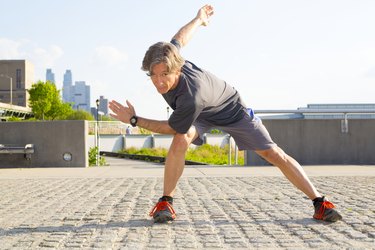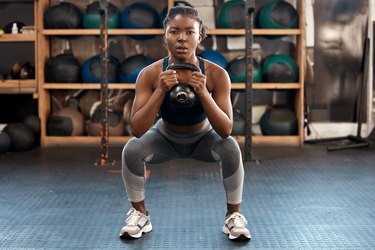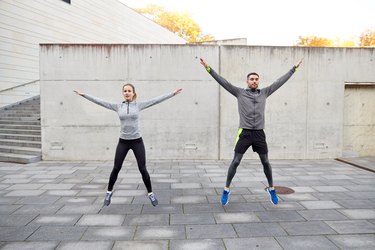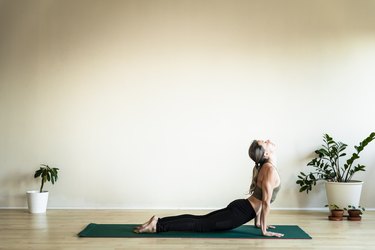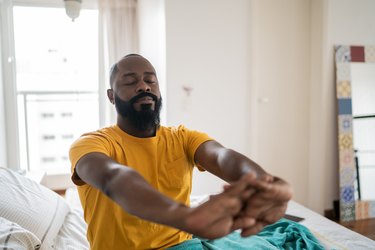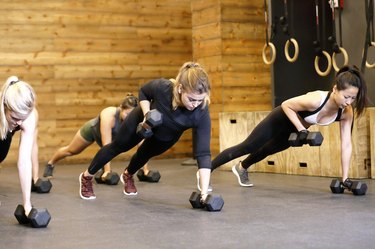
Snapping, cracking and popping are noises you might expect to hear from your morning bowl of cereal, but not from your elbows during a workout. If you've ever experienced your elbows cracking while doing push-ups or other upper body exercises, you may wonder what's the deal with those disconcerting noises.
Fear not: Joint cracking and popping during workouts is common and usually harmless, according to the Cleveland Clinic. If you don't have any pain along with elbow popping, you're most likely fine to keep doing what you're doing. But it's still worth knowing why your elbow makes noise during workouts, so here are seven possible reasons why.
Video of the Day
Video of the Day
1. Your Joint Is Releasing Gas
In general, elbow popping or cracking without pain has a harmless and very common cause — cavitation, or the release of gases from your joints. Your joints contain a lubricating solution called synovial fluid, which contains oxygen, nitrogen and carbon dioxide.
"Occasional, painless popping sounds that do not affect the range of motion of the elbow are considered normal," says Erin Nance, MD, an upper extremity orthopedic surgeon. "It is thought that the popping sound comes from the movement of air inside the joint fluid as the joint is compressed by motion."
Fix it: Don't change anything — cavitation is totally normal and can actually make your joints feel better. Trapped gases can make your elbow feel tight or immobile, and allowing those gases to release loosens things up.
2. Tight Muscles or Tendons Rub the Bone
Tight tendons can cause a snapping sensation in your elbow joint when you flex or extend your arm, in addition to popping or cracking sounds. Tight muscles can exacerbate this and limit your range of motion, causing pain similar to muscle soreness.
Fix it: Warm up before your workout and cool down after. Your warm-up should include movements that prime your biceps, triceps, shoulders and forearms for exercise, such as light-weight overhead presses or modified push-ups.
Your cooldown should include static stretching; foam rolling is also a good addition. If you have pain along with noise and a snapping feeling, visit your doctor and ask about tendinitis and snapping elbow syndrome, both of which are tendon-related elbow complications.
3. You Have an Elbow Sprain
An elbow sprain occurs when a ligament in your elbow joint gets stretched (minor) or completely torn (severe). A minor elbow sprain may cause popping, cracking or "catching" of your elbow joint alongside minor pain.
Fix it: You can treat minor sprains at home with rest, ice, compression and over-the-counter pain-relief medications. If you have a severe sprain that's causing intense pain or seriously limiting your range of motion, it's best to see a doctor.
4. Loose Bodies in Your Elbow Joint
The phrase may sounds like something from a horror movie, but "loose bodies" refers to small pieces of cartilage or bone inside of the elbow joint. They can also cause popping and locking of the elbow, Dr. Nance says. This is generally diagnosed through an X-ray or advanced imaging, such as a CT scan or magnetic resonance imaging (MRI).
Fix it: There's not much you can do about this without a diagnosis. If you do receive a diagnosis of loose bodies, you may need surgery to remove the fragments.
5. Arthritis Is Causing the Joint to Deteriorate
If you're young and generally healthy, it's unlikely that you have arthritis of the elbow, but the likelihood increases with age and for those with rheumatoid arthritis, the autoimmune type of arthritis (the other kind, osteoarthritis, involves age-related degeneration of joints).
Fix it: Treatment for arthritis depends on the type of arthritis and other factors, but generally includes rest, lifestyle changes, physical therapy and sometimes medication, according to the Mayo Clinic. If you think you have arthritis, ask your primary care doctor to refer you to a rheumatologist.
6. Part of Your Elbow Joint Is Inflamed
Sometimes, bands of tissue in the elbow joints called "plicas" can become inflamed. An inflamed plica is often the culprit behind snapping over the outside of the elbow, Dr. Nance says.
If chronic, doctors refer to this as "plica syndrome" or elbow synovial fold syndrome, according to a July 2013 article from the American Journal of Roentology. It's often accompanied by altered movement patterns, limited range of motion and pain on the outside of your elbow. You may also experience a "catching" sensation when you bend your arm.
Fix it: An inflamed plica may resolve on its own, but if it doesn't, physical therapy and anti-inflammatory pain medications are usually the treatment of choice. Some doctors also recommend steroid injections.
7. Cartilage in the Elbow Has Separated
In a somewhat rare condition called osteochondritis dissecans, blood supply to part of the cartilage and subchondral bone (layer of the bone that lies beneath the cartilage) in the elbow joint stalls or stops completely, according to the American Academy of Orthopedic Surgeons.
This loss of blood supply may cause a fragment of cartilage and bone to separate from the joint, and this fragment may get caught somewhere in the joint, resulting in pain, limited range of motion and cracking sounds. While it usually occurs in children and adolescents, it can also happen in adults.
"Repetitive overhead and upper extremity weight bearing are risk-factors for osteochondritis dissecans," Dr. Nance says, and this condition often develops in overhead athletes and swinging or throwing athletes (such a golfers and pitchers).
Fix it: Only a doctor can diagnose this condition, but if you suspect you have it, you should stop any activity that causes pain until you can see a doctor.
Other Ways to Treat or Prevent Elbow Popping
If you're experiencing joint pain that's kind of annoying but not really bad enough to seek medical care, check to make sure you are performing any weight-lifting exercises with proper form, Dr. Nance says. Poor lifting form can cause dull aches and joint popping and can eventually lead to injury if not corrected.
You may notice that the popping only happens in certain positions, say, when your elbow is fully extended or fully flexed or when your forearm is rotated up or down. Being aware of the positions that cause you pain can help you either avoid such positions or work on your form during particular exercises.
For example, when performing push-ups, you might discover that rotating your elbow closer to your body — versus pointing your elbows outward — reduces or completely eliminates pain and popping sounds.
When to See a Doctor
You don't need to see a doctor for elbow popping if you don't experience any pain when your elbow joint makes noise. In the case of minor elbow pain, ice and anti-inflammatory pain medications, such as Ibuprofen, can help ease the pain and reduce any swelling.
But pain — especially severe pain — indicates injury and should be evaluated by a doctor, especially if it's persistent. If you have other symptoms, particularly numbness or instability, you should see a doctor, even if the pain is only minor. Other worrisome symptoms include swelling, limited range of motion, bruising or discoloration or tingling.
- Cleveland Clinic: Snap, Crackle, Pop: What You Need to Know About Joint Noises
- PLoS One: Real-Time Visualization of Joint Cavitation
- ScienceDirect: Synovial Fluid - An Overview
- World Journal of Orthopedics: Snapping elbow-A guide to diagnosis and treatment
- Mayo Clinic - Diseases & Conditions: Osteoarthritis
- OrthoInfo - Diseases & Conditions: Osteochondritis Dissecans
- American Journal of Roentgenology: Elbow Synovial Fold Syndrome
- Mayo Clinic - Diseases & Conditions: Tendinitis
- Mayo Clinic - Tests & Procedures: MRI
- Mayo Clinic - Tests & Procedures: CT Scan
Is this an emergency? If you are experiencing serious medical symptoms, please see the National Library of Medicine’s list of signs you need emergency medical attention or call 911.
